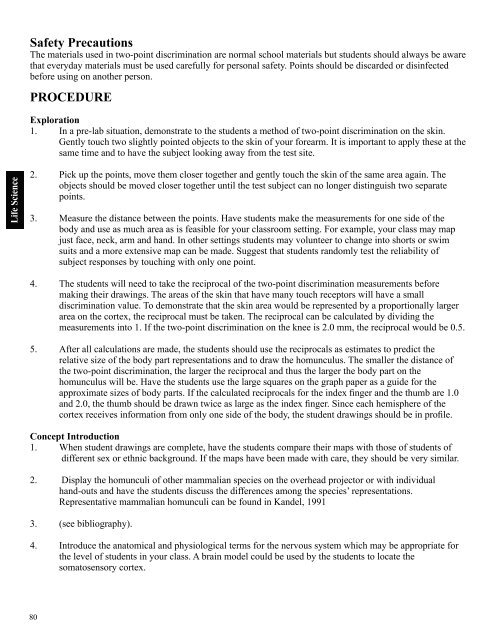ScienceMakers Toolkit Manual - The History Makers
ScienceMakers Toolkit Manual - The History Makers
ScienceMakers Toolkit Manual - The History Makers
You also want an ePaper? Increase the reach of your titles
YUMPU automatically turns print PDFs into web optimized ePapers that Google loves.
Life Science<br />
Safety Precautions<br />
<strong>The</strong> materials used in two-point discrimination are normal school materials but students should always be aware<br />
that everyday materials must be used carefully for personal safety. Points should be discarded or disinfected<br />
before using on another person.<br />
PROCEDURE<br />
Exploration<br />
1. In a pre-lab situation, demonstrate to the students a method of two-point discrimination on the skin.<br />
Gently touch two slightly pointed objects to the skin of your forearm. It is important to apply these at the<br />
same time and to have the subject looking away from the test site.<br />
2. Pick up the points, move them closer together and gently touch the skin of the same area again. <strong>The</strong><br />
objects should be moved closer together until the test subject can no longer distinguish two separate<br />
points.<br />
3. Measure the distance between the points. Have students make the measurements for one side of the<br />
body and use as much area as is feasible for your classroom setting. For example, your class may map<br />
just face, neck, arm and hand. In other settings students may volunteer to change into shorts or swim<br />
suits and a more extensive map can be made. Suggest that students randomly test the reliability of<br />
subject responses by touching with only one point.<br />
4. <strong>The</strong> students will need to take the reciprocal of the two-point discrimination measurements before<br />
making their drawings. <strong>The</strong> areas of the skin that have many touch receptors will have a small<br />
discrimination value. To demonstrate that the skin area would be represented by a proportionally larger<br />
area on the cortex, the reciprocal must be taken. <strong>The</strong> reciprocal can be calculated by dividing the<br />
measurements into 1. If the two-point discrimination on the knee is 2.0 mm, the reciprocal would be 0.5.<br />
5. After all calculations are made, the students should use the reciprocals as estimates to predict the<br />
relative size of the body part representations and to draw the homunculus. <strong>The</strong> smaller the distance of<br />
the two-point discrimination, the larger the reciprocal and thus the larger the body part on the<br />
homunculus will be. Have the students use the large squares on the graph paper as a guide for the<br />
approximate sizes of body parts. If the calculated reciprocals for the index fi nger and the thumb are 1.0<br />
and 2.0, the thumb should be drawn twice as large as the index fi nger. Since each hemisphere of the<br />
cortex receives information from only one side of the body, the student drawings should be in profi le.<br />
Concept Introduction<br />
1. When student drawings are complete, have the students compare their maps with those of students of<br />
different sex or ethnic background. If the maps have been made with care, they should be very similar.<br />
2. Display the homunculi of other mammalian species on the overhead projector or with individual<br />
hand-outs and have the students discuss the differences among the species’ representations.<br />
Representative mammalian homunculi can be found in Kandel, 1991<br />
3. (see bibliography).<br />
4. Introduce the anatomical and physiological terms for the nervous system which may be appropriate for<br />
the level of students in your class. A brain model could be used by the students to locate the<br />
somatosensory cortex.<br />
80










